A 7-day itinerary in South Korea
A couple of months ago, I went on a week-long trip to South Korea. Since then, I have written several posts about Seoul, with a focus on places for book lovers, cafes, bars and restaurants. Today, however, I’m finally sharing my recommendations for a 7-day itinerary in South Korea. This itinerary is largely based on the one I followed, but has been optimised to help you make the most of your time in Seoul, Busan and Gyeongju.
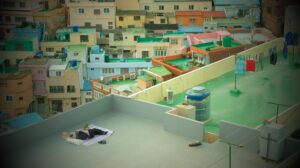
Day 1 – Seoul
Having taken an afternoon flight from Paris to Seoul, I landed in South Korea the following morning. The flight was about 12 hours long and the time difference between West Europe and South Korea is 7 hours.
From the Incheon International Airport, I took the train to Seoul and then the metro to Jongno 3-ga station, where I’d booked accommodation nearby (Dajayon Hanok Stay). The whole journey lasted just over an hour. Once I checked in, I set to explore the neighbourhood.
Where to eat and drink – day 1
Cheongsudang Bakery was the first stop of my 7-day itinerary in South Korea. It is located in the Ikseon-dong Hanok Village, very close to where I stayed. As well as a café, it is also a patisserie specialising in yakgwa, a traditional Korean dessert. A yakgwa is basically a deep-fried honey cookie. The name ‘yakgwa’ consists of two syllables, ‘yak’ (medicine) and ‘gwa’ (confection), so it actually means ‘medicinal confection’. This is because honey was considered to be medicinal.
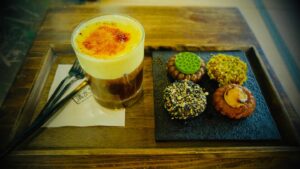
A bit further away, but within walking distance, is Imun Seolnongtang. This is a famous restaurant which opened in 1904 and was the first eatery in Korea to officially register for a restaurant license. To this day, it honours the tradition of boiling ox bones for 17 hours until the broth turns rich and opaque. I actually had lunch there on my second day, after visiting the nearby Gyeongbokgung Palace. However, on reflection, I would recommend this to be your first lunch in Seoul. Depending on the time of your arrival, you might want to go there first and pay a visit to Cheongsudang Bakery later.
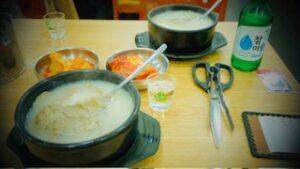
Located at the lower level of the Four Seasons Hotel, Charles H. is a cocktail bar I would definitely recommend. I went there at around 6 pm and had a Bing Cha Spritz, which I really enjoyed, as well as the speakeasy atmosphere of the bar.
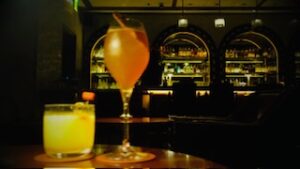
Jogyesa Temple
As far as sightseeing is concerned, you don’t have to go far. Jogyesa Temple is nearby and well worth a visit. South Korea has two major religions: Christianity and Buddhism. Whereas Buddhism enjoys a longer presence in the country, Christianity is the largest religion today. Jogyesa is the chief temple of the Jogye Order of Korean Buddhism. The building dates back to the late 14th century.
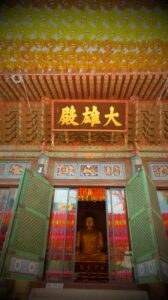
Day 2 – Seoul
On my second day in Seoul, I had breakfast at Onion, which is apparently one of the most famous cafes in Seoul. It is very close to Changdeokgung Palace and the Bukchon Hanok Village. I got there at around 11 am. There were 2 queues outside, one for dine-in, the other one for take-out/dine-out. Inside, there was another queue to order. All the queues were very slow, due to not having enough staff (there were lots of empty tables). Overall, I waited in the queue for about an hour, and spent much less time sitting. There was a good selection of sweet pastries as well as savoury items, but not that great to make the whole waiting worthwhile. If there is a queue, just give it a miss and find another cafe or go to the Bukchon Hanok Village.
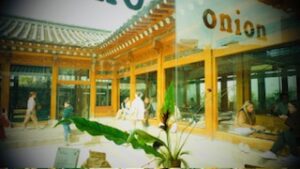
Bukchon Hanok Village and Gyeongbokgung Palace
The Bukchon Hanok Village is a residential neighbourhood in Seoul. It has many restored traditional Korean houses, called hanok. This has made it a popular tourist destination, which has caused some friction with the residents who live there. There are also a few places where you can stop for coffee or tea.
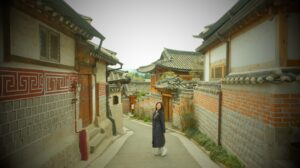
Afterwards, I continued to the Gyeongbokgung Palace. Built in 1395, the Palace of Shining Happiness (as is also called), is the largest of the Five Grand Palaces built by the Joseon dynasty. It served as the home of the royal family and the seat of government but is now open to the public. The changing of the guard takes place at 10 am and 2 pm every day except Tuesdays, and lasts about 20 minutes.
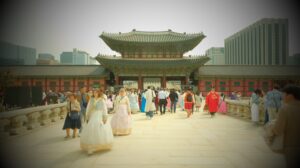
Some places for book lovers
Located in Seochon Village on the west side of Gyeongbokgung, Daeo Bookstore is the oldest in Seoul. It is named after a married couple, Cho Dae-sik and Kwon Oh-name, who founded it back in the 1950s. Nowadays, it is a second-hand bookstore as well as a little café. It is open in the afternoons and evenings. I had an iced yuzu and lemon tea for 6,500 won (£4). Cash only.
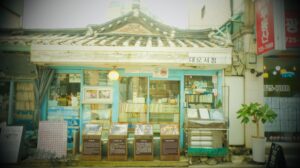
After my visit to the Daeo Bookstore, I walked towards the entrance of Gyeongbokgung and from there down Sejong-daero. Kyobo Bookshop is on Jong-ro (on the left as you walk down Sejong-daero). As you enter the bookshop, you will notice a Starbucks straight ahead. On the right, there is a section selling books (including many by Korean authors) and magazines in English. It is open daily, from 9.30 am to 10 pm.
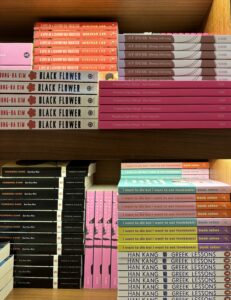
Not far from there, Cheonggyecheon is an 11km stream flowing west to east through downtown Seoul, and then meeting Jungnangcheon, which connects to the Han River and empties into the Yellow Sea. The total length of the Han River is approximately 514 kilometres. Although it is not a long river, the lower Han River is remarkably broad. Within Seoul city limits, the river is more than 1 kilometre wide.
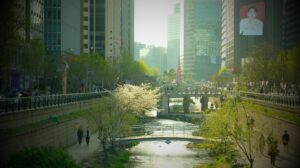
Where to eat and drink – day 2
For dinner, I would recommend Kyoja. This is a famous restaurant in Seoul’s Myeongdong neighbourhood. It is not too far to walk there from Cheonggyecheon. They only have 4 dishes on the menu, but when I dined there, they’d sold out one (kongguksu). I tried the rest and I liked them all. My favourite was the noodle soup (kalguksu). Fast service and excellent value for money.
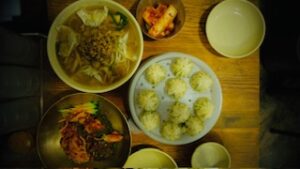
Afterwards, I wandered around Myeongdong (Korean for bright neighbourhood). Although I had just eaten, I couldn’t resist trying a few more Korean delicacies (mostly sweet) at Myeongdong’s street food market. Myeongdong is known for being one of Seoul’s main shopping districts. In 2023, it was listed as the ninth most expensive shopping street in the world. It is also known for being home to the Cathedral Church of Our Lady of the Immaculate Conception, also known as simply the Myeongdong Cathedral.
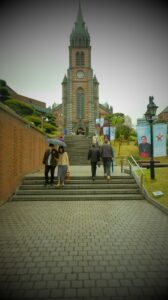
Day 3 – Seoul
On my third day in Seoul, I had breakfast at Mil Toasthouse. This is a café also located in the Ikseon-dong Hanok Village. The house speciality is the steamed bread, which is worth trying. I got there mid-morning and had to join a rather slow-progressing queue. If there is a queue, just give it a miss and find another café. In fact, not far from Mil Toasthouse, also in the Ikseon-dong Hanok Village, there’s Soha Salt Pond. Although I did not visit this one, I went to Soha Salt Pond in the city of Yeongju (and I really liked it).
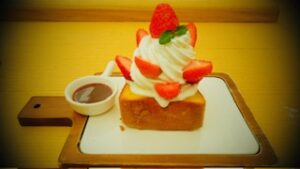
Changdeokgung Palace
Afterwards, I went to the nearby Changdeokgung Palace. This was the second royal villa built following the construction of Gyeongbokgung Palace in 1405. It was the principal palace for many kings of the Joseon dynasty, and is the most well-preserved of the five remaining royal Joseon palaces. Changdeokgung Palace was designated as a UNESCO World Heritage in 1997 and is regarded as a Korean palace architecture masterpiece with buildings in perfect harmony with nature. The palace’s garden behind the inner hall, called the “Secret Garden,” was constructed during the reign of King Taejong and served as a rest area for the royal family members. To avoid disappointment, make sure you book your tickets in advance.
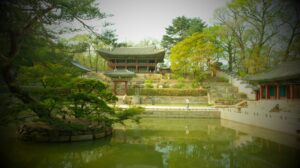
Gagnam style
From there, I would suggest you take the metro to Gagnam, on the other side of the river. Nudake is one of my favourite patisserie-cafés in Seoul and I would highly recommend it. They specialise in croissants, and they have a big selection of both sweet and savoury pastries. Some are inspired by traditional Korean dishes/flavours, such as kimchi and hotteok. Pastries aside, I really enjoyed the décor, including some oversized croissants!
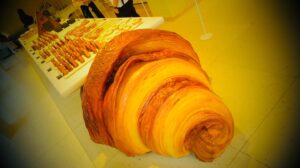
Nudake is not too far from the Starfield Library – also well worth a visit. It is located inside the COEX Mall, one of the city’s premier malls and the world’s largest underground mall. The two-story library has 13-meter-tall bookshelves and is home to more than 50,000 books. Inside the library, there is also a Starbucks (one of the nearly 2,000 stores in the country), as well as Korea’s first % Arabica. The Starfield Library is open daily, from 10.30 am to 10 pm.
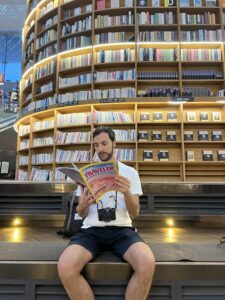
If the weather is pleasant, continue to Banpodaegyo Bridge. This is a two-tiered bridge over the Han River that features the Moonlight Rainbow Fountain (the world’s longest bridge fountain recognized by the Guinness Book of World Records) with 380 water jets and a dazzling array of multicoloured lights. The musical fountain light-up show runs 4 to 5 times daily (in the evening) from April to October.
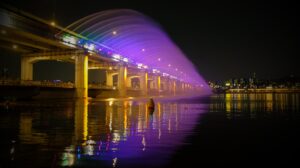
Where to eat and drink – day 3
For dinner, I would recommend a restaurant called 밥도사 술도사. It is located close to the Jongno 3-ga metro station (the gateway to the Ikseon-dong Hanok Village). Here I had my first experience of Korean barbeque. Although they did not have built-in grills, they provided us with portable stoves to use at our table. The atmosphere was great and the food was delicious!
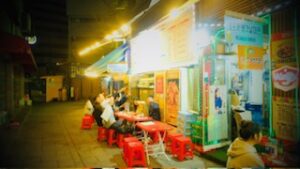
Alternatively, I would recommend dining at one of the many restaurants on Donhwamun-ro 11-gil. Although I didn’t manage to, I had the gut feeling it would also have been an authentic but great gastronomic experience.
Not far from there, there’s Ounce, a queer-friendly cocktail bar. I really enjoyed the sophisticated atmosphere, as well as the cocktail I tried (Midnight in Seoul). The bar is located on the ground floor of the Top Hotel & Residence.
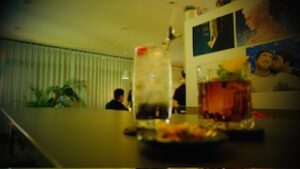
Day 4 – Seoul to Busan
Gwangjang Market
Gwangjang Market is one of the oldest and largest traditional markets in South Korea, with more than 5000 shops and 20,000 employees in an area of 42,000 m2. Approximately 65,000 people visit the market each day, and I am happy to say that I was one of them. I actually liked it so much that I visited twice. If you don’t have time to go twice, skip breakfast and go on an empty stomach.
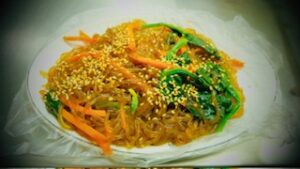
During my visits, I tried many traditional Korean delicacies, such as tteokbokki (a popular and delicious Korean dish – chewy rice cakes cooked in a red, spicy broth), bindaetteok (mung bean pancakes), dumplings, pork rind, japchae (glass noodles), and kalguksu (hand-cut noodle soup). I had the latter at the same stall that was featured on the Netflix TV series Street Food Asia. Overall, I really loved the food but I also enjoyed the experience of eating around the food stalls.
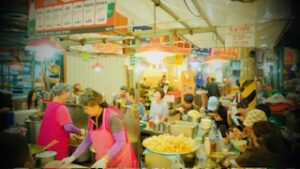
One of the most memorable and unique gastronomic experiences I’ve ever had, was when I tried sannakji. This is a raw dish made with octopus, which is killed before being cut into small pieces and served. The nerve activity in the octopus’s tentacles makes the sliced pieces move posthumously on the plate when served. The dish is sprinkled with sesame oil and toasted sesame seeds and goes well with soju.
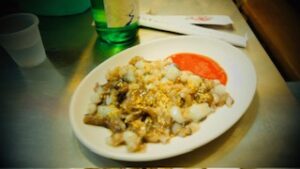
Where to stay in Busan
After my lunch at the Gwangjang Market, I took the KTX train to Busan, South Korea’s second most populous city after Seoul. The journey was about 2 hours. Although Busan is a coastal city, I stayed at 25hours Hotel, a modern hotel in a very lively neighbourhood in central (inland) Busan.
Day 5 – Busan
Haeundae Blueline Park and Haedong Yonggungsa Temple
On my first day in Busan, I headed to Haeundae Blueline Park. This is an eco-friendly redevelopment of the former railroad facilities of the Donghae Nambu Line, a 4.8-kilometer-long stretch from Haeundae’s Mipo to Cheongsapo to Songjeong. It forms a part of the new core of the Haeundae Tourism Special Zone, an international tourist region in Busan that operates the Haeundae Beach Train and Haeundae Sky Capsule along Haeundae’s spectacular coastal scenery. To avoid disappointment, make sure you book your tickets in advance.
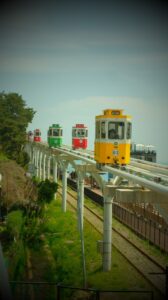
From there, I continued (by bus) to the nearby Haedong Yonggungsa Temple. Situated on the coast of the northeastern part of Busan, this temple is considered the most beautiful in Korea.
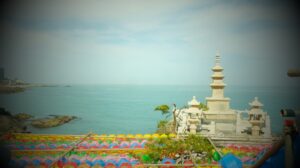
Gamcheon Culture Village and Jagalchi Market
In the afternoon, I took a taxi to the Gamcheon Culture Village. Built on a steep mountain-side slope, the village has been nicknamed “Machu Picchu of Busan”. Its brightly painted houses, have been restored and enhanced in recent years to attract tourism.
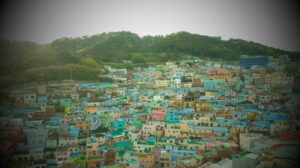
In the evening, I walked down to the Jagalchi Market, where I had dinner. Located on the seaside road in Busan’s Jung-gu, it is Korea’s largest seafood market, selling both live and dried fish.
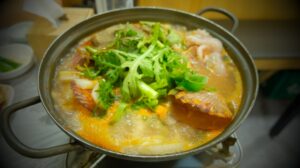
Day 6 – Day trip to Gyeongju
Gyeongju is a relatively small coastal town, about an hour’s drive from Busan. It was the capital of the ancient kingdom of Silla, which ruled about two-thirds of the Korean peninsula for close to one thousand years. Often referred to as “the museum without walls”, Gyeongju has now become one of the most popular tourist destinations in South Korea.
Rather than spend the night there, I decided to visit on a day trip from Busan. I picked a 12-hour tour which offered a great opportunity to visit some of the city’s landmarks, as well as the surrounding area.
Bulguk-sa Temple and Yangdong Folk Village
We got picked up from Busan at 10 am and arrived at the Bulguk-sa Temple at around midday. This is a head temple of the Jogye Order of Korean Buddhism and contains six National Treasures, including the Dabotap and Seokgatap stone pagodas, Cheongun-gyo (Blue Cloud Bridge), and two gilt-bronze statues of Buddha. The temple is classified as Historic and Scenic Site No. 1 by the South Korean government. In 1995, Bulguksa was added to the UNESCO World Heritage List.
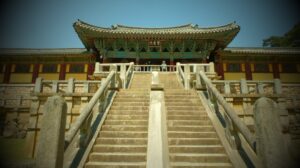
The next stop was the Yangdong Folk Village, where we had lunch first, then went on a stroll around the village and learned about its history. Yangdong is a traditional yangban (Korean Aristocracy) village from the Joseon dynasty. It is also a UNESCO World Heritage Site and is located sixteen kilometres northeast of Gyeongju. This was my least favourite part of the itinerary.
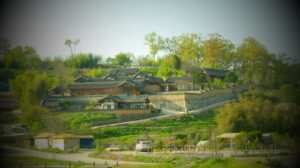
Gyeongju
Afterwards, we headed to Gyeongju, where we first visited Daereungwon Tomb Complex, before having some free time to wander on the nearby Hwangnidan-gil Road and the surrounding area. I stopped at Soha Salt Pond, a beautiful cafe where I had coffee and pastries, including several variations of the house speciality, the salted bread.
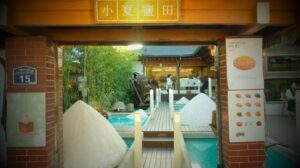
We then went to the Woljeong Bridge, in time for the sunset. It was built during the Unified Silla period, but was burnt down during the Joseon dynasty. It was then rebuilt in the 21st century and is now the largest wooden bridge in Korea.
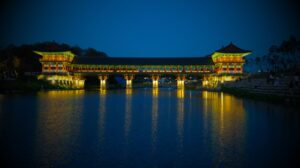
Last, we visited the Donggung Palace and the Wolji Pond, part of the palace complex of ancient Silla. By the time of our visit, it was dark, so I enjoyed the reflections of the palace on the pond (despite being very crowded, possibly because it was a Saturday in early April – cherry blossom season). We returned to Busan at around 10 pm.
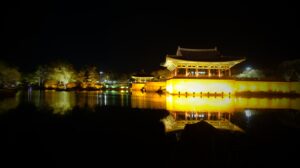
Day 7 – Busan to Seoul
The following day of my 7-day itinerary in South Korea, I took the train back to Seoul and arrived there at midday.
Where to eat and drink – day 7
Seoul Station is relatively close to the Namdaemun Market. This is another large market, albeit an outdoor one. It is located near Myeongdong, but closes early, so it’s not suitable for dinner. Hotteok is a pancake filled with a sweet mixture, which may contain brown sugar, honey, chopped peanuts, and cinnamon. It is a very popular street food in Korea. Nowadays, alternative fillings, including savoury ones, can also be found. I tried it at the Namdaemun Market – the stall was right in front of the IBK bank (Gate 2).
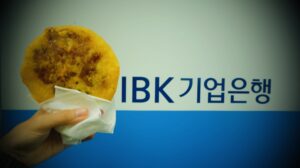
Also close to the train station, but on the opposite side, there’s Dutum, a famous samgyeopsal (pork belly) restaurant. It is very popular with locals, and it was actually some Seoulites who recommended it to me. Korean barbeque restaurants like Dutum are extremely very popular in Korea. A gas or charcoal grill is built into the dining table itself, and it is often the customers who grill their meat. The meat is then enjoyed with kimchi and various other condiments. It goes well with soju, a popular alcoholic beverage traditionally made from rice.
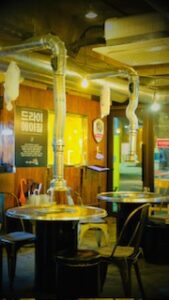
A dolsot (“stone pot”) or gopdolsot (“agalmatolite pot”) is a small-sized piece of cookware or serveware made of agalmatolite, suitable for 1-2 servings of bap (cooked rice). In Korean cuisine, various hot rice dishes such as bibimbap or gulbap (oyster rice) as well as plain white rice can be prepared and served in dolsot. As a dolsot does not cool off as soon as removed from the stove, rice continues to cook and arrives at the table still sizzling. I tried it at 담솥 연남점, a restaurant near Hongik University metro station.
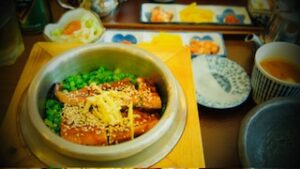
More places for book lovers
Located between Hongik University station and Sinchon, the Gyeongui Line Book Street was named after the Gyeongui Line on which it was built. I had read that Book Street was lined with train-carriage-like bookshops, but when I visited these were empty. Nonetheless, I enjoyed walking down this pedestrianised street/park, eventually having coffee at Picniq, which was filled with books by the Japanese novelist Haruki Murakami (translated into Korean).
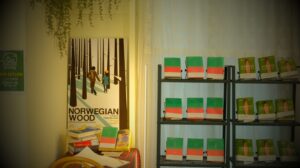
Where to stay in Seoul
That night, I stayed at PIPE Hostel Yeonnam in Hongdae, in Western Seoul, an area popular with students. Although Dajayon Hanok Stay was better location-wise, both places were equally good, as well as reasonably priced.
Further reading
If you’re planning a trip to Korea, I’d recommend the Lonely Planet Korea.
Alex
(the Traveling Psychiatrist)